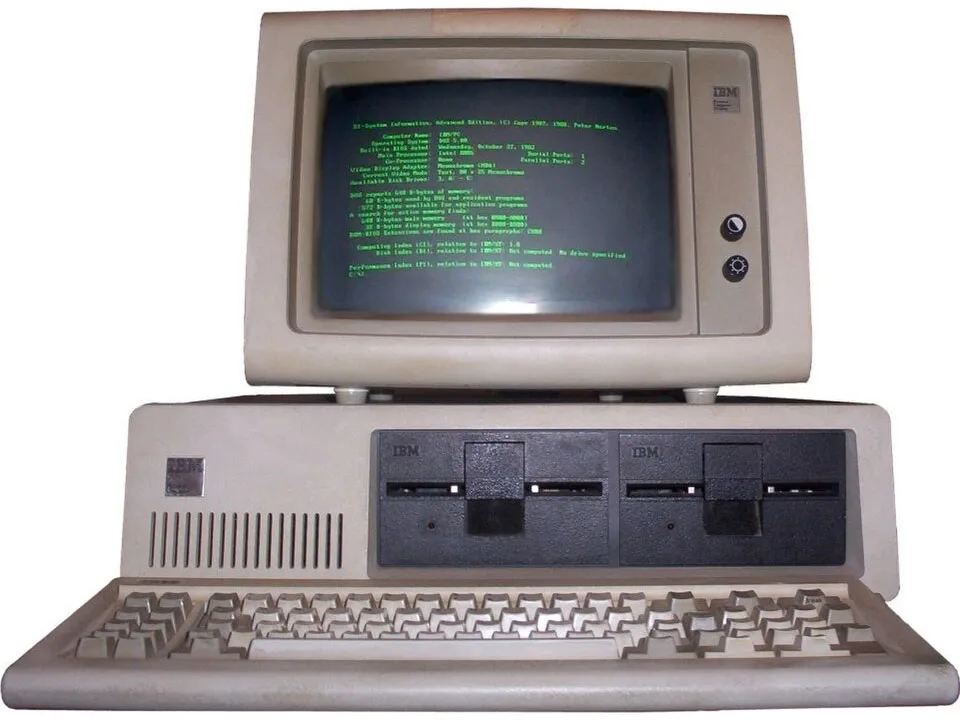The IBM PC: A Revolution in Personal Computing
The IBM Personal Computer (PC), released on August 12, 1981, wasn’t the first personal computer, but it was arguably the most important. It fundamentally changed the landscape of computing, shifting it from a hobbyist pursuit to a mainstream business and personal tool. Here’s a deep dive into its history, specifications, impact, and legacy:
1. The Context: Before the IBM PC
- Early Personal Computers: Machines like the Altair 8800, Apple II, and Commodore PET were pioneering, but they were often sold as kits, required significant technical knowledge, and lacked a unified standard.
- IBM’s Hesitation: IBM, a dominant force in mainframe computers, initially dismissed the personal computer market as insignificant. They feared it would cannibalize their lucrative mainframe business.
- The IBM PC Project: A small team within IBM (led by Don Estridge), was tasked with quickly developing a PC to compete with the growing market. They operated with a different, faster pace than typical IBM projects.
2. Key Features & Specifications (Original IBM PC – Model 5150)
- Processor: Intel 8088 (4.77 MHz) – This was a crucial decision. IBM chose the 8088 over the more powerful 8086 to maintain compatibility with existing peripherals designed for the 8-bit 8080 processor.
- Memory: 16 KB RAM (expandable to 640 KB) – 16KB was the base configuration, but the ability to expand was vital.
- Storage: No hard drive initially. Used cassette tapes or 5.25-inch floppy disk drives (single or dual). Hard drives became available later.
- Operating System: PC-DOS (developed by Microsoft) – IBM contracted Microsoft to provide the operating system. Microsoft retained the rights to sell PC-DOS to other manufacturers, a pivotal move. Later, MS-DOS became the dominant OS.
- Display: Monochrome Display Adapter (MDA) – Text-only, 80×25 characters. Color Graphics Adapter (CGA) was available as an option, offering limited color graphics.
- Ports: Serial ports, parallel port, keyboard port, and a cassette interface.
- Open Architecture: This was the key to the IBM PC’s success. IBM published the technical specifications of the PC, allowing other companies to create compatible hardware and software. This fostered a massive ecosystem.
- Price: Around $1,565 (equivalent to over $5,000 today) for a basic configuration.
3. Why the IBM PC Succeeded (and its Impact)
- IBM Brand Recognition: The IBM name carried immense weight and credibility, especially in the business world. Companies trusted IBM.
- Open Architecture: As mentioned, this allowed for rapid innovation and competition. “IBM Compatible” became the standard.
- Business Focus: IBM targeted the business market, offering software like VisiCalc (a spreadsheet program) that was essential for businesses.
- Microsoft’s Role: Microsoft’s PC-DOS/MS-DOS became the dominant operating system, and their software (like Word) became essential applications.
- The Rise of the “Clone” Market: Because of the open architecture, companies like Compaq, Dell, and others quickly began manufacturing “IBM PC clones” – computers that were compatible with the IBM PC standard but often cheaper. This drove down prices and increased accessibility.
- Software Development Boom: The IBM PC platform attracted a huge number of software developers, creating a vast library of applications for every conceivable purpose.
- Shift in Computing Power: The PC brought computing power to individuals and small businesses, empowering them in ways previously unimaginable.
4. Evolution of the IBM PC (Key Models & Generations)
- PC XT (1983): Added a hard drive (10MB), increasing storage capacity significantly.
- PC AT (1984): Featured the faster Intel 80286 processor, improved graphics, and a more powerful motherboard. The AT form factor became a standard for many years.
- PC/386 (1988): Introduced the Intel 80386 processor, enabling 32-bit computing and improved performance.
- PC/486 (1989): Featured the Intel 80486 processor, with integrated math coprocessor and further performance gains.
- PC/586 (1990s): Continued evolution with faster processors (Pentium, etc.), improved graphics, and increased storage. IBM eventually exited the PC hardware market in 2005, selling its PC division to Lenovo.
5. Legacy and Influence
- The Wintel Duopoly: The IBM PC’s success cemented the dominance of the “Wintel” platform – the combination of Windows (Microsoft’s operating system) and Intel processors.
- The PC Standard: The IBM PC architecture became the de facto standard for personal computers, influencing designs for decades.
- The Modern Computing Landscape: The IBM PC laid the foundation for the modern computing world, including laptops, tablets, and smartphones.
- The Rise of the Software Industry: The PC created a massive market for software, driving innovation and economic growth.
Where to find more information
- IBM PC History: https://www.ibm.com/history/personal-computer
- Wikipedia – IBM PC: https://en.wikipedia.org/wiki/IBM_PC
- Computer History Museum: https://www.computerhistory.org/
In conclusion, the IBM PC wasn’t just a computer; it was a catalyst for a technological revolution. Its open architecture, business focus, and the power of the IBM brand combined to create a platform that transformed the world. Even though IBM no longer manufactures PCs, its legacy continues to shape the computing landscape we know today.
